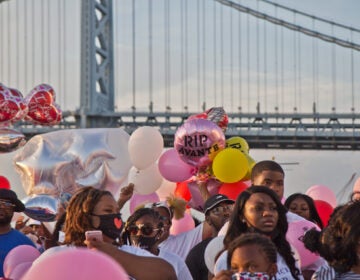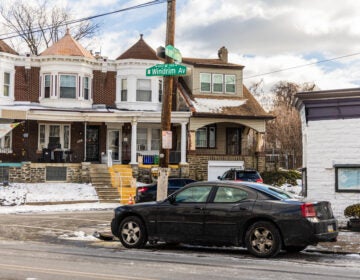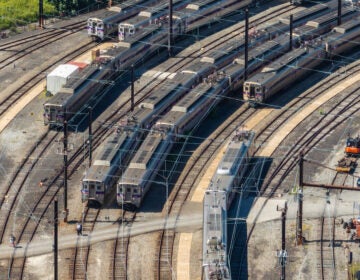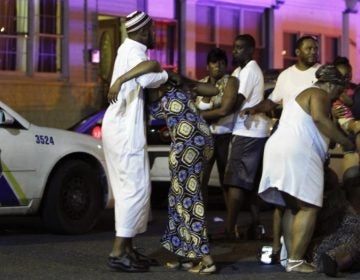Racism and deadly traffic on Cobbs Creek Parkway
Cobbs Creek residents have been complaining that the road is dangerous for decades. Neighbors there have called for greater safety measures, but little has changed.
Listen 16:45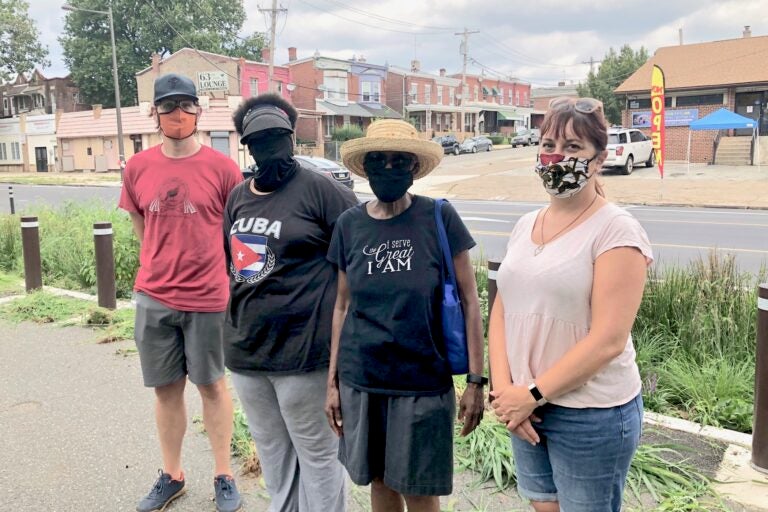
Cobbs Creek neighbors (from left) Leonard Bonarek, Lisa Love, Marthenia Perrin and Larissa Mogano stand at Cobbs Creek Parkway and Catharine Street, where Avante Reynolds was killed in a hit and run. They’ve been pushing for traffic-calming devices on Cobbs Creek Parkway for a decade. (Michaela Winberg/WHYY)
Avante Reynolds was a new mom with a growing YouTube following when she was killed in a hit and run on Cobbs Creek Parkway in West Philly a few weeks ago. She was only 25. But the driver is not the only one responsible for her death.
Accidents and late-night drag racing are common on the parkway, a four-lane highway that separates Black residential neighborhoods from a park. Neighbors there have been complaining and calling for greater safety measures for decades, but little has changed.
Michaela Winberg, reporter for WHYY’s Billy Penn, dug deep into the long history of racist policies that have led communities of color to live near dangerous roadways like the Cobbs Creek Parkway and their calls for change to be ignored.

Hear the whole story on The Why
Interview highlights
On what makes Cobbs Creek Parkway so dangerous
Cobbs Creek Parkway, it’s this 12 mile road. Most of it is four lanes. The posted speed limit is 35 miles per hour, which is not that fast, but speeding is a huge problem. A lot of people pass each other on the left lane. Even on the parts of the parkway where it’s only two lanes, one going in each direction, they’ll pass and go into the opposing lane. And it runs right through, on one side, a mostly Black residential neighborhood, and, on the other side, this really big park, Cobbs Creek Park, with a couple rec centers, tennis courts, basketball courts, a playground, a bike trail — things people in the neighborhood right across the parkway would want to access. It’s this really important public space, but to access [it] they have to cross the parkway. And it’s a really, really busy street. It connects Delaware County all the way up to Market Street in West Philadelphia. Tens of thousands of cars drive the parkway every single day.
On how roads like this end up in residential neighborhoods
There’s a long history of why transit decisions like this are made, and a lot of it really traces back to redlining. It’s this systemic practice that the government created in the 1930s that singled out areas based on desirability linked to racial and ethnic makeup of residents, so it made it difficult for people to get mortgages or investments in neighborhoods where Black people, people of color and immigrants lived. So those neighborhoods lose value. In a lot of cities, highways were built to spatially reinforce those racial lines on the map; they were built right through Black neighborhoods. Cobbs Creek, the history is a little more complex. Originally areas around the park were not redlined — it was a desirable area. But the route of the parkway was designed to go through Black, redlined areas, so we do see that impact today.
On residents’ requests for safety measures not being met
It’s unfortunately not that uncommon. It’s part of this troubling pattern that you see across the entire United States: that communities of color can’t get access to traffic safety measures as easily as predominantly white neighborhoods can.
So Tamika Butler, she’s a civil rights attorney and the former executive director of the Los Angeles Bicycle Coalition. I talked to her a little bit about this. And it really didn’t strike her is very surprising. [She said,] “Black folks dying in neighborhoods, based on getting hit by cars, when it seems like this community has been asking for some traffic calming for a while, that is another form of racism in this country.”
And you can you can see that point that Butler is making illustrated really plainly in Philadelphia’s traffic fatality statistics. So that High Injury Network that lists Philly’s most dangerous roads … half of the roads that are on that — so half of the most dangerous roads — are in communities of color, predominantly Black neighborhoods like Cobbs Creek.
WHYY is your source for fact-based, in-depth journalism and information. As a nonprofit organization, we rely on financial support from readers like you. Please give today.



